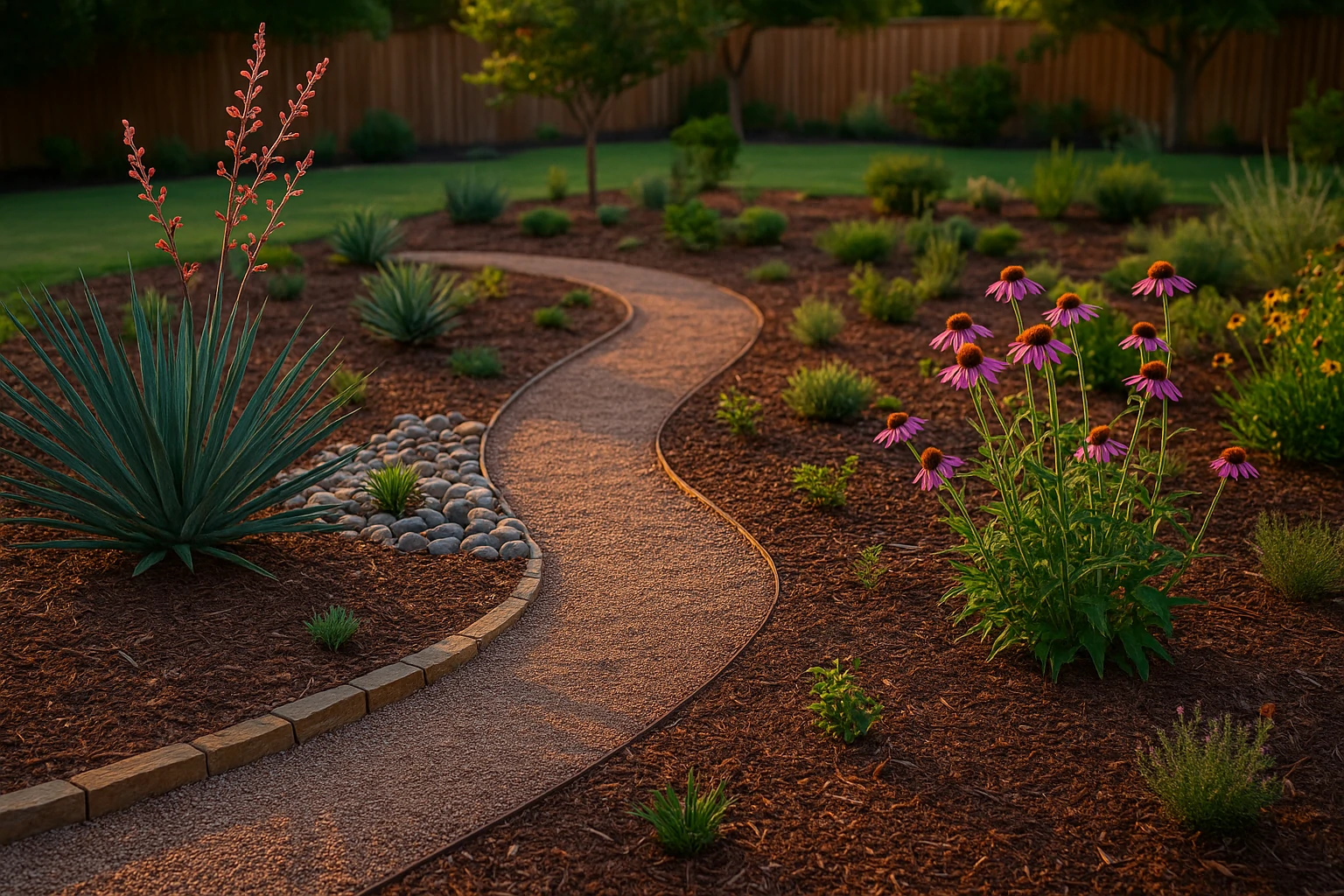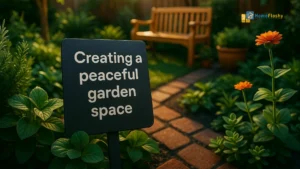A yard does not need to be high effort to look good. Many people in Texas want a clean, beautiful space that does not take too much work. Long weekends spent watering, trimming, or replacing plants can drain time and energy. This guide will help you avoid that. You will see smart ideas that fit the Texas climate and cut back on your chores.
Texas weather changes a lot. Some regions stay dry for weeks, others get sudden rain. You need a yard that can survive both. Droughts hit hard, especially in central and west Texas. Water restrictions also pop up often. These facts make low maintenance landscaping more than just a trend. It becomes a smart choice.
Many homeowners want to save money too. Hiring help costs a lot. Wasting water costs even more. Simple design choices can lower those bills. This does not mean your yard must look dull. It only means you need to pick the right plants, shapes, and features.
This guide shows you how to do that. It gives you practical steps. You will learn how to use rocks, mulch, native plants, and smart designs. Each tip helps your yard stay neat without constant work. Read on to plan a space that fits your time, budget, and Texas lifestyle.
Know Your Texas Climate Zone
Texas covers several USDA climate zones. The zone you live in affects which plants survive best in your yard. Do not guess. Check the zone chart and find your city. Areas near Dallas and Austin sit in Zone 8. Houston and the coast are Zone 9. West Texas drops to Zone 7. Panhandle regions may even hit Zone 6.
Each zone means different challenges. In hotter areas, plants need to handle heat, sun, and dry soil. In cooler areas, frost can damage weak roots. Picking the right plant for your zone means less water, less care, and less stress. Native plants often fit the zone already. They adjust well and grow strong on their own.
You also want to watch soil types. Central Texas has limestone and clay. East Texas offers sandy or loamy soil. Run a simple soil test if you’re unsure. Choose plants and ground covers that match it. If your soil drains fast, pick drought-tolerant plants. If it holds water, avoid deep-rooted species.
Shade and wind matter too. Big trees can block light. Strong wind can dry out the soil. Pay attention to these details before you start. They help you build a yard that works with nature, not against it.
Start with a Clean Layout
Before you pick any plant, shape your yard with a plan. Use lines, borders, and paths to split the space into zones. A smart layout gives order. It keeps plants from crowding or spreading too far. It also helps you manage water and control weeds.
Use gravel or stone walkways to move between areas. This keeps foot traffic off the grass. It also adds style and breaks up large spaces. Curved edges work better than sharp corners. They look soft and need less trimming.
Group plants based on sunlight needs. Place shade plants under trees or north walls. Put sun-lovers in open spots. This simple move helps each plant thrive without extra effort. You also save water, since each group has similar needs.
Keep the lawn small or skip it. Lawns take time, water, and fertilizer. A large grassy yard adds work, not value. You can use artificial turf, gravel, or native ground cover instead. These choices stay neat with little care.
Best Low Maintenance Landscape Ideas for Small Texas Yards
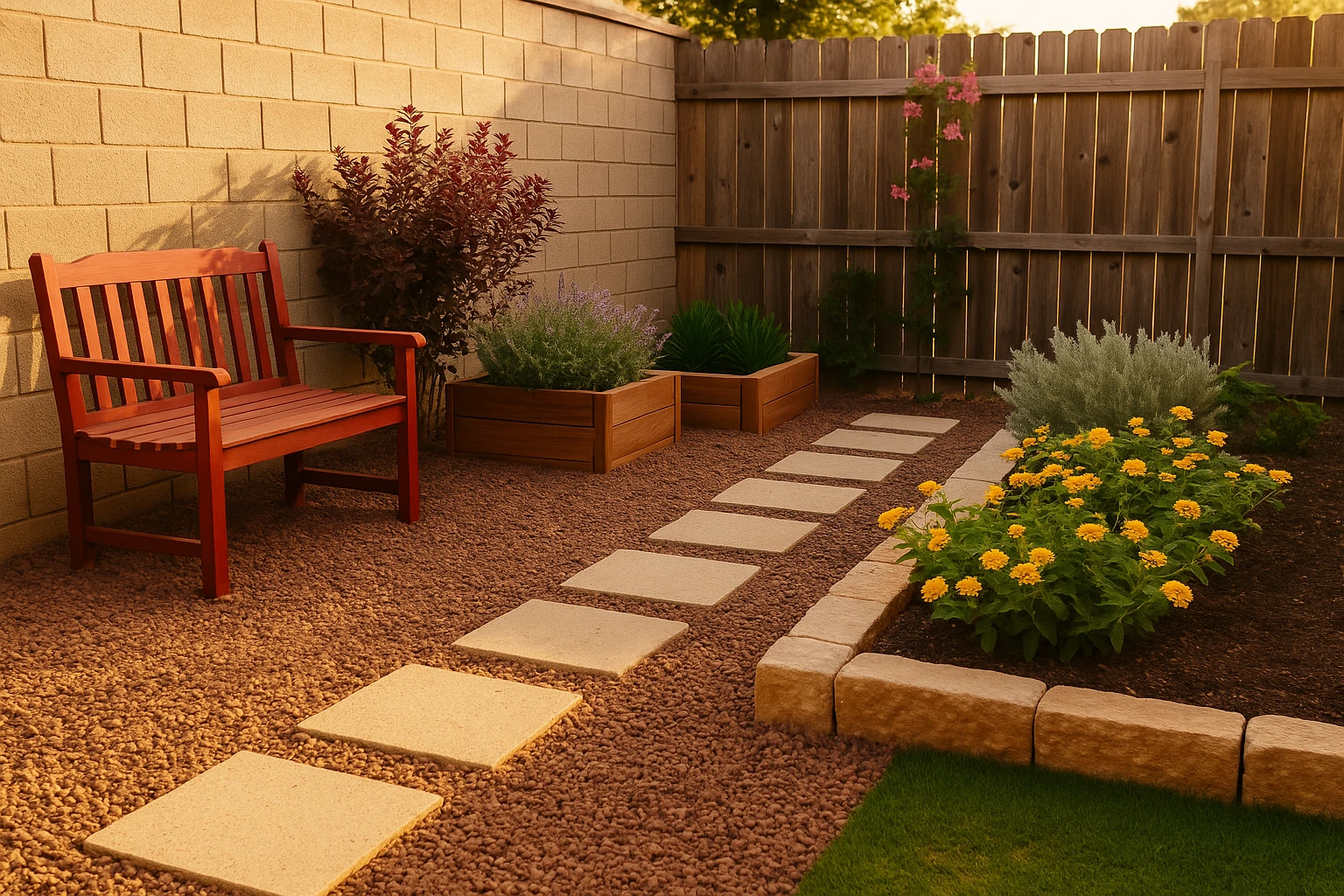
A small yard does not limit your design. In Texas, you can still create a calm, clean space without much work. You only need smart use of space and the right materials.
Start with scale. Choose small or dwarf plants that do not grow wide. Use narrow beds along fences or walls. This keeps the space open and tidy. Raised beds also work well in small yards. They add height and make care easy.
Limit your lawn. Use gravel, pavers, or mulch in open areas. Add one or two focal points. A small bench, a large planter, or a metal sculpture draws the eye and reduces clutter. Simple designs create a peaceful look.
Vertical space helps too. Hang pots on fences or install a trellis. Vines like crossvine or coral honeysuckle grow upward and bloom often. This adds color without using up floor space.
In small Texas yards, every detail counts. Clean lines, low care plants, and smart storage turn even tight spaces into a relaxing retreat.
Use Native and Drought-Tolerant Plants
Texas has many plants that grow strong without help. They know the soil, heat, and dry air. Native plants beat fancy flowers or tropical greens in both beauty and strength. Some even attract bees, butterflies, or birds.
Try these native plants in your design:
- Texas Sage: Shrub with purple flowers. Loves sun and heat.
- Mexican Feather Grass: Adds motion and texture.
- Blackfoot Daisy: Small white flowers. Tough and low water.
- Red Yucca: Spiky base, tall flower stalks. Needs no fuss.
- Purple Coneflower: Bright blooms that return each year.
Drought-tolerant plants from other dry regions also work well. Think of agave, sedum, lavender, rosemary, and lantana. They handle full sun, hold their shape, and ask for little water.
Plant in clusters. A group of three or five plants looks better than single ones. It also keeps roots cool and blocks weeds. Space them well. Give each one room to grow so you don’t prune too often.
What to Avoid in a Texas Low Maintenance Yard
Some choices look good at first but cause more work later. A few simple mistakes can turn an easy yard into a struggle. Avoid these traps and your landscape will stay stress-free.
Do not choose high-water plants. Many people buy plants for looks without checking if they fit the climate. Tropical plants or lush grass need daily watering and shade. They dry fast and die in Texas heat. Stick with hardy, local types that match your soil and sun.
Avoid thin or fake mulch. Cheap mulch fades, blows away, or holds no moisture. Pick natural wood mulch or gravel that lasts through summer storms. A strong layer keeps soil cool and stops weeds.
Do not forget drainage. Flat yards with no slope collect water after rain. That causes puddles, root rot, and mosquito growth. Add gentle grading or drains so water runs away from the house.
Skip large, bright lawns or fancy fountains. They need mowing, cleaning, or power. Simple textures, stone paths, and drought-tolerant plants give more beauty with less work. Smart design saves your time and money.
Replace Grass with Hardscaping
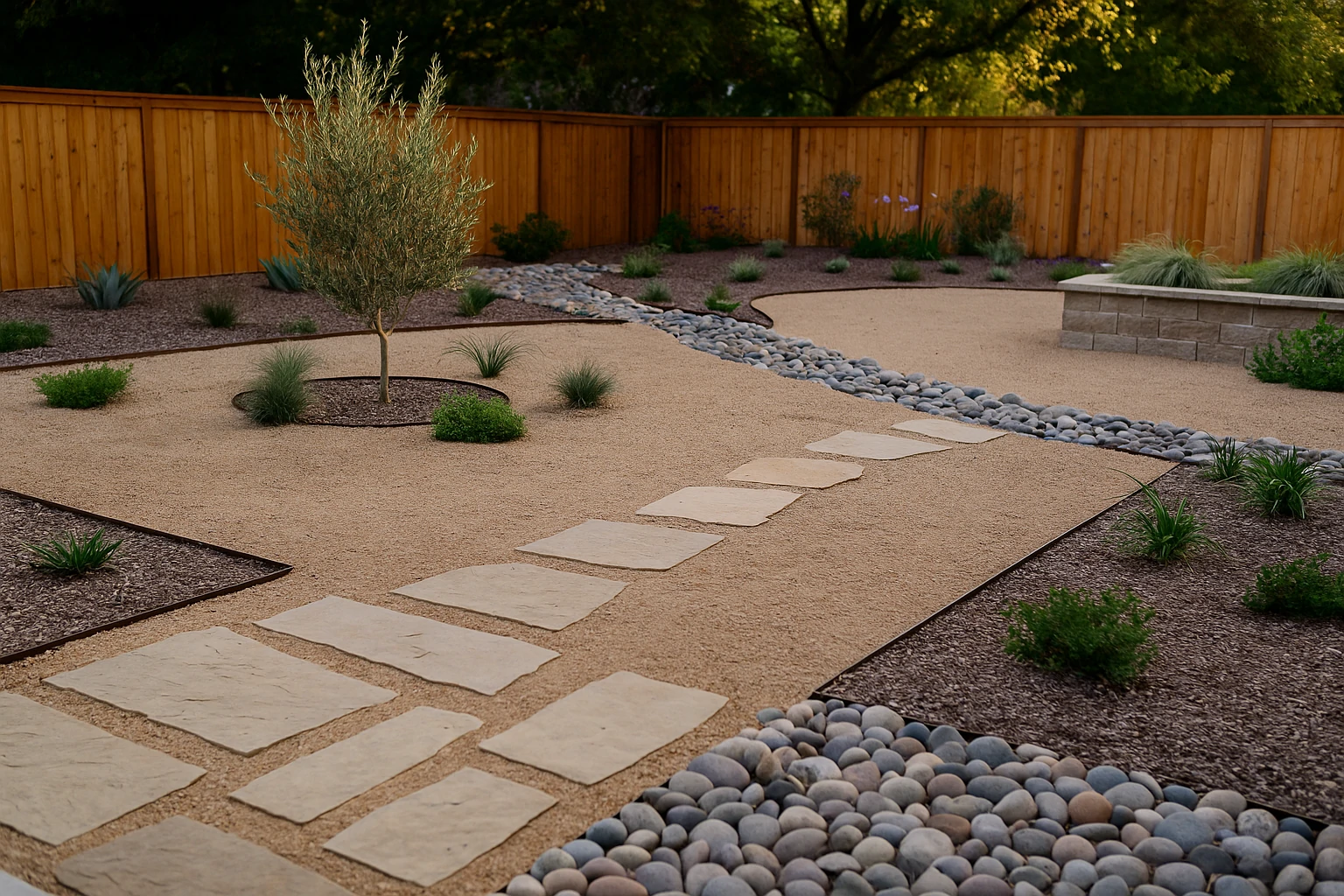
Grass looks green, but it needs constant mowing and water. Many Texans now switch to hardscaping. That means adding rocks, pavers, or gravel in place of turf. Done right, it looks stylish and clean.
Flagstone patios add usable space. Decomposed granite works great for paths. River rock fills gaps around plants. You can mix colors and textures to match your home. Use metal or stone borders to keep everything in place.
Crushed granite, pea gravel, or lava rock all help control weeds. They also reflect heat away from plant roots. Add weed fabric under each layer to boost results. A solid hardscape cuts work and water needs in half.
Balance hard areas with soft ones. Place a bed of native plants near your path. Add potted succulents near seating areas. A few bright spots of green will soften the look and keep the space welcoming.
How to Landscape Without Grass in Texas
You do not need grass to have a clean, green yard. Many Texans now drop grass to save time and water. A no-lawn yard looks sharp, costs less, and feels just as peaceful.
Start with the base. Use gravel, decomposed granite, or crushed limestone to fill space. These materials drain well and match the Texas look. Add metal edging to hold the shape. This keeps things neat and tidy.
Layer in structure. Use large planters, stone borders, or raised beds. These features give form and help divide areas. You can create zones for sitting, planting, or walking without any turf.
Fill open spots with tough plants. Choose native shrubs, cactus, or bunch grasses. They grow well in heat and do not need mowing. You can also mix in potted plants for color and height.
Add shade and seating. A simple bench under a tree makes your yard feel finished. A no-grass yard should still feel soft and inviting. Think of it as an outdoor room, not a work zone.
Best Artificial Grass Options for Texas Heat
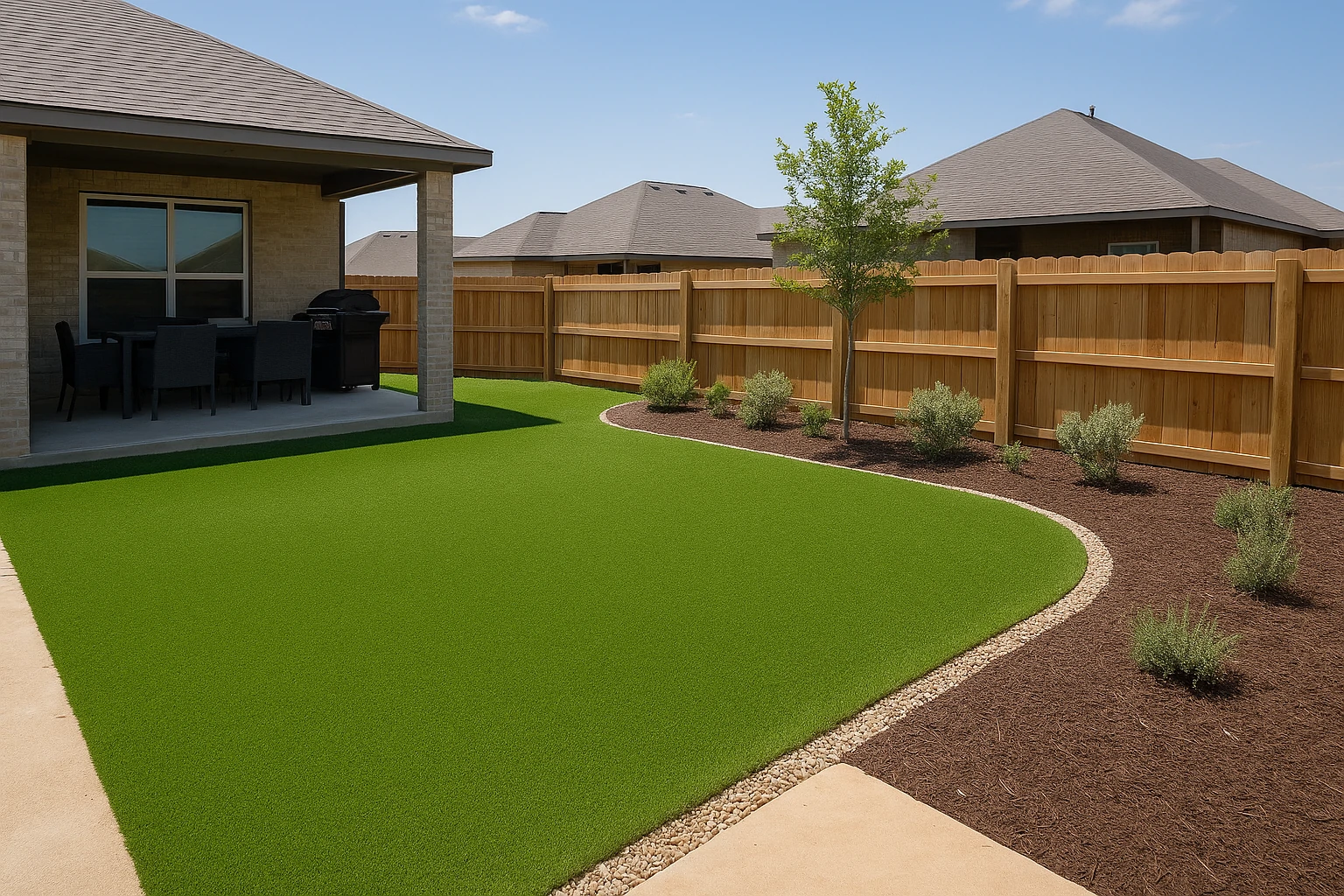
Artificial grass can be a smart choice in Texas. It stays green, needs no water, and never needs mowing. It works well in front yards, pet areas, or shaded spots where real grass fails.
Not all turf is equal. Choose one that handles heat, drains fast, and feels soft underfoot. Some brands also offer UV protection so the color does not fade. Look for turf made for hot, dry climates. These types resist melting or curling under full sun.
Infill matters too. Crumb rubber feels soft but may get hot. Silica sand stays cooler and adds weight to keep turf in place. Pick infill based on your use. Pet turf often needs special fill to control odor.
Keep the base strong. Dig out old soil and use crushed granite as a base. This helps with drainage and keeps the turf smooth. Compact the base before installing turf. Use stakes or glue to secure edges.
Artificial grass costs more upfront, but it pays off over time. You save on water, tools, and care. It also holds up for years with almost no effort.
Choose the Right Mulch
Mulch does more than cover dirt. It locks in moisture, keeps soil cool, and blocks weeds. It also breaks down and feeds the soil over time. That’s why mulch matters in low-effort yards.
Use organic mulch like bark, wood chips, or pine straw. Spread a layer about 2–3 inches thick. Do not pile it near plant stems. Leave a small ring clear to avoid rot. Replace mulch once a year or when it looks thin.
Avoid dyed mulch. The color fades fast in the sun. It may also hurt soil life. Use natural colors like brown or dark tan. They match most yards and homes. In dry areas, gravel mulch works too. It does not break down, but it helps reflect heat and keeps weeds low.
Mulch also helps shape the yard. Use it around tree bases, in flower beds, or near fences. It adds contrast and defines space. Just don’t forget to refresh it now and then.
Texas-Friendly Landscaping on a Budget
A nice yard does not need to cost much. Texas homeowners can design beautiful landscapes with smart planning and simple choices. The goal is to use what you have and spend only where it matters.
Start with local materials. Rocks, gravel, and native plants cost less when bought nearby. They also handle the Texas climate better. Recycled bricks or stones can create clean borders or short paths. Old wood can frame raised beds or act as edging.
Plant seeds instead of full plants. Seeds grow slower but save a lot of money. Mix wildflower or grass seed that fits your zone. Once they take root, they return every year. Native plants also need less water and care, saving more in the long run.
Reuse water where possible. Set a barrel under a gutter to collect rainwater. Use it for shrubs and pots. This keeps your bill low and helps during dry spells.
Do not rush to fill every space. Let plants grow and spread over time. A half-full bed will fill out within months. A budget landscape can still look natural and complete if planned with patience and care.
Use Raised Beds and Containers
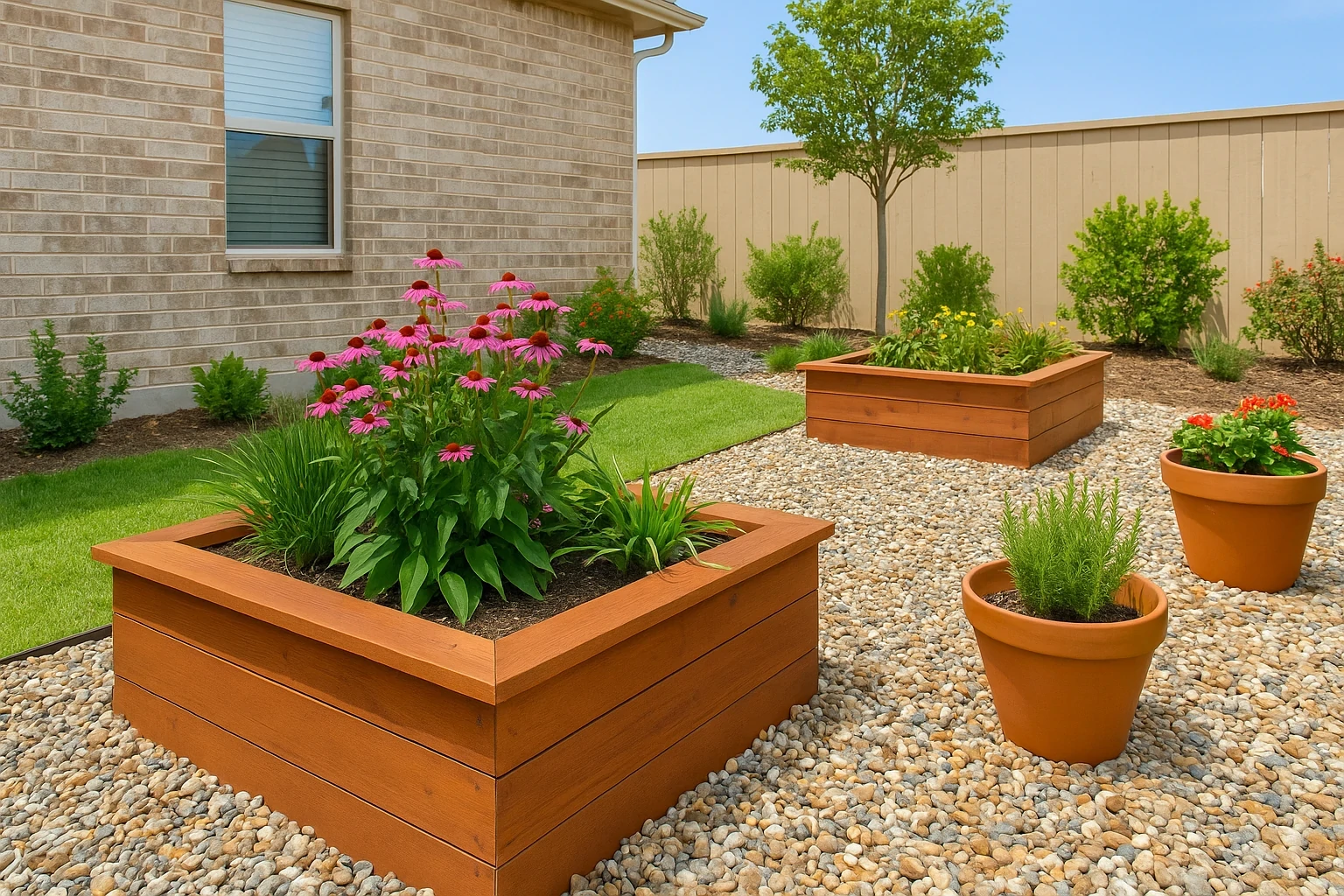
Sometimes, soil problems block plant growth. Raised beds fix this fast. You control the soil, shape, and drainage. That means fewer weeds, better growth, and no back pain.
Build beds with stone, brick, or treated wood. Keep them short and wide, about 1–2 feet high. Fill them with mix soil and compost. Then plant native flowers, herbs, or shrubs. Raised beds look neat and stay low effort.
Containers also work well. Use clay, ceramic, or recycled plastic pots. Match the size to the plant. Drainage holes are a must. Group containers by need. Use saucers under them to stop leaks and stains.
Place pots near doors, on patios, or near windows. They add charm without crowding your yard. You can also move them if the weather shifts or the light changes.
Shade-Tolerant Plants for Texas Backyards
Not all plants love the Texas sun. Some yards have big trees, north-facing walls, or covered patios. These spots stay cooler but still need green life. The right shade plants keep those areas full without much work.
Start with ferns. River fern and Southern wood fern grow well in dappled light. They stay green most of the year and spread slowly. They also need little trimming once settled.
Try Turk’s cap for bright red blooms. It grows under trees and pulls in hummingbirds. It handles drought once rooted and comes back each year. American beautyberry also grows in shade and gives bold purple berries in fall.
Ground covers help fill shady corners. Horseherb, Frogfruit, and Strawberry begonia spread wide and grow low. These plants stop weeds and reduce mud after rain.
Even shady areas can thrive if planted right. Use compost to build soil, water deeply but less often, and keep mulch thick. These steps help your shade garden stay low effort and full of life.
Sun-Loving Plants That Need Little Water
Texas has long, hot summers. Some parts get little rain for weeks. You need plants that love full sun and still stay strong. These sun-lovers bring color and shape without constant care.
Try these drought-tolerant, sun-loving plants:
-
Texas Lantana: Blooms bright all season. Handles dry soil and full sun. Attracts butterflies and needs no extra watering.
-
Red Yucca: Grows bold flower spikes on tall stalks. Returns each year. The base stays low and tidy. Works well near stone paths.
-
Purple Coneflower: Stands upright with strong roots. Blooms last through dry heat. Reseeds on its own and draws birds and bees.
-
Autumn Sage: Compact plant with soft red or pink flowers. Thrives in small spaces like raised beds or walkways.
-
Blackfoot Daisy: Small, white blooms. Grows in rocky soil and full sun. Adds gentle color with very low care.
Full sun does not mean hard work. Give each plant space to grow. Water deeply at first. Once established, they handle the heat with little help.
Deer Resistant Low Maintenance Plants in Texas
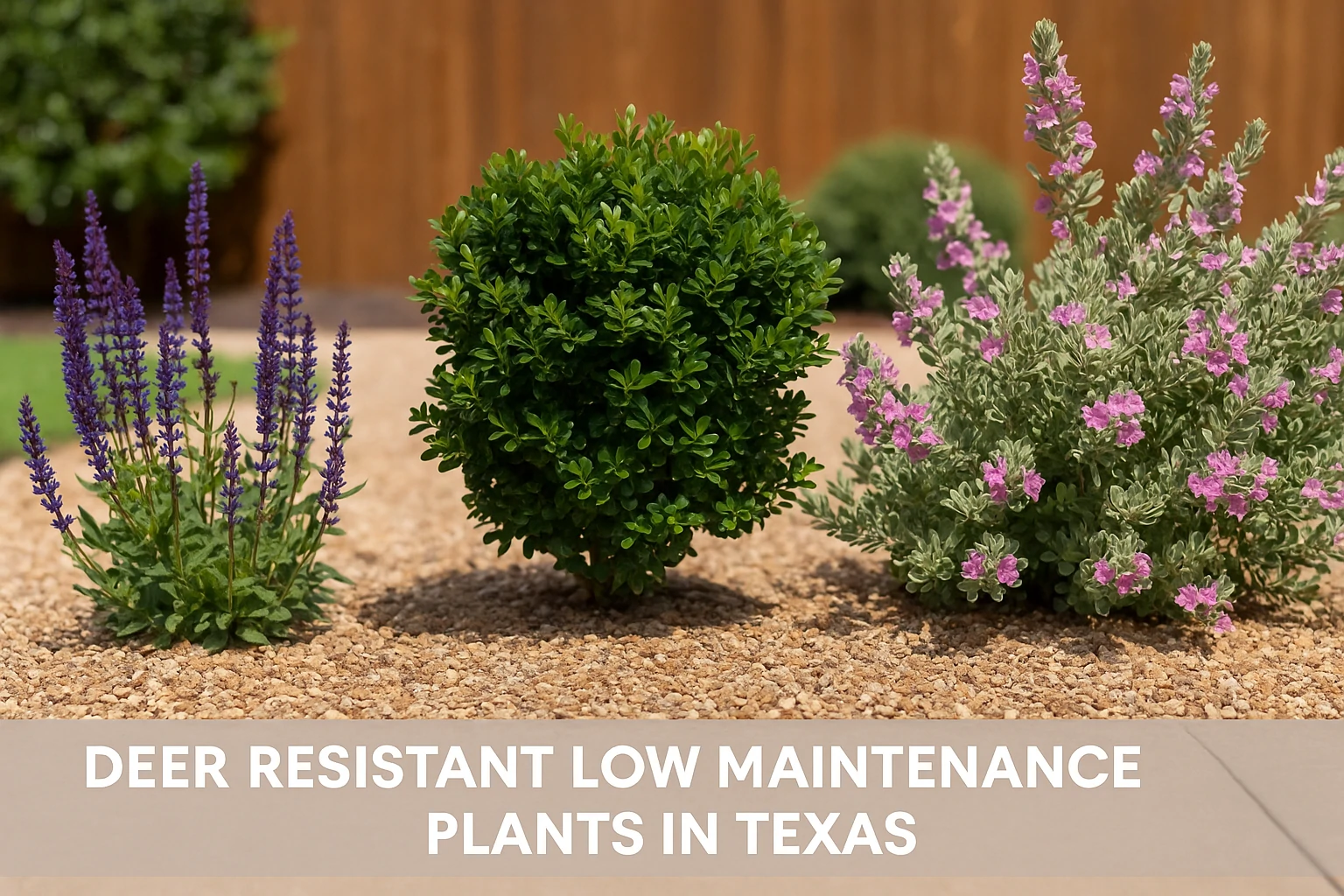
In many Texas towns and rural areas, deer walk through yards like they own them. They eat flowers, leaves, and even bark. This ruins your landscape and costs you time. Choose deer-resistant plants to stop the damage before it starts.
- Yaupon holly stands strong. Deer avoid its bitter leaves. It keeps shape all year and needs little pruning. Dwarf versions work well in beds or along paths.
- Texas sage looks soft but deer leave it alone. It blooms in purple waves and handles dry soil. Once rooted, it grows without help.
- Lavender adds scent and gray color. Its oils keep deer away. It fits in rock gardens or along patios. Just give it sun and good drainage.
- Society garlic has purple flowers and a strong smell. Deer avoid the taste. It grows in clumps and works well near walkways or fences.
Avoid soft, sweet plants like roses or hostas. Deer love those. Stick to tough, bold, and bitter options. These plants protect your yard and still look great with very little care.
Pet-Friendly Low Maintenance Landscapes
Pets need space to play, rest, and stay safe. Your yard can meet their needs without adding more work. A few smart choices make it easy to care for both your landscape and your furry friend.
Use tough ground covers. Grass wears out fast under paws. Try Kurapia, Frogfruit, or Artificial turf in high-traffic zones. These options stay green and soft without water or mowing.
Skip plants that hurt. Avoid Sago palm, Oleander, or Foxglove. These are toxic to dogs and cats. Use safe plants like Rosemary, Snapdragons, or Marigolds instead. They look nice and cause no harm.
Add shade and water. A tree, shade sail, or covered patio gives pets a cool place to rest. Use shallow water bowls or fountains with fresh water. Change it often to keep it clean.
Create paths and borders. Dogs like to patrol the edge of the yard. Lay a clear path with gravel or mulch. Keep plants out of that zone so they do not get crushed.
Pet-friendly design keeps your yard clean, calm, and fun. You get more time to relax, and your animals stay safe and happy.
Add Shade Where You Can
Texas heat can roast plants and people. Shade helps both. Trees, pergolas, or shade sails reduce sun stress. They also cut water loss from soil. That means less work and fewer plant deaths.
Try native trees like live oak, desert willow, or Texas redbud. They grow slow but strong. Their roots go deep, and they need less water once mature. Place them where they block harsh sun but not views.
A pergola adds charm and function. Use it to cover patios or seating areas. Vines like coral honeysuckle or crossvine can grow over them. These plants bloom, attract birds, and stay tidy.
Shade sails offer a fast fix. You can install them over paths, beds, or corners that bake in the heat. Pick neutral colors to blend in. Secure them well to avoid damage in wind.
How to Use Xeriscaping in Texas Without Losing Beauty
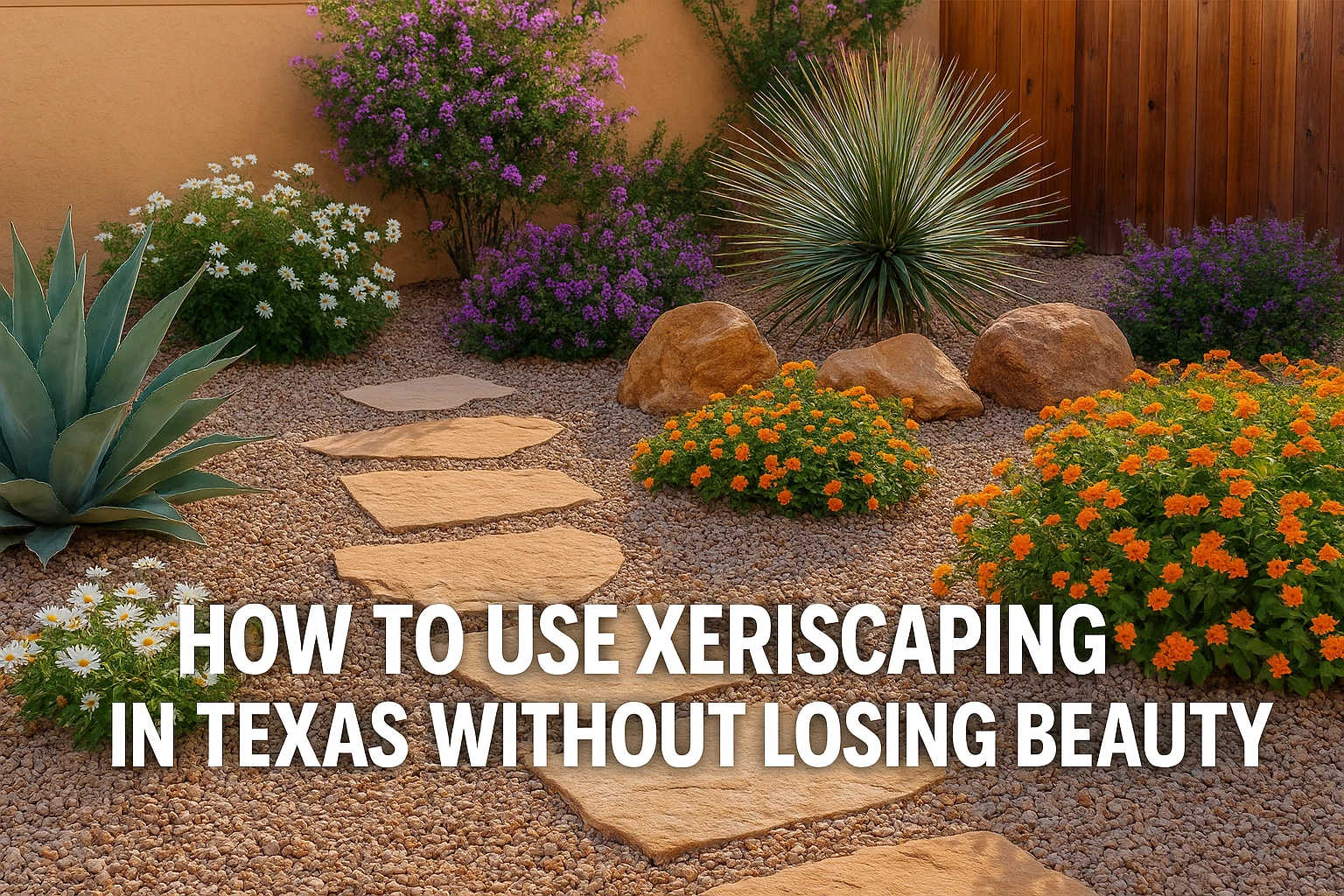
Xeriscaping means using less water, not losing style. In Texas, smart design can still look rich and full. You just need the right mix of plants, stone, and shape.
Start with strong layout lines. Use gravel paths, metal borders, or stone slabs to define spaces. Clean shapes add order and make the yard feel finished.
Pick plants with bold form. Use Agave, Red yucca, and Texas sotol for structure. Add Blackfoot daisy, Lantana, or Salvia for color. These plants live with little water and still bloom often.
Layer textures. Mix coarse rocks with soft leaves. Use mulch under shrubs and pea gravel between beds. A mix of textures adds depth and keeps things clean.
Limit color but use it well. A few bright plants draw the eye more than many dull ones. Group three or five of the same plant for stronger impact. Fewer types mean less care.
Xeriscaping in Texas works best when simple. You save water, cut work, and still get beauty. It is not dry or boring, it is smart and lasting.
Install Smart Irrigation
Even drought-tolerant yards need water sometimes. But you do not want to waste it. A smart irrigation system helps you water only when and where needed. That saves time and cuts the bill.
Use drip lines for beds and shrubs. They place water right at the roots. No mist. No waste. You can cover the lines with mulch to hide them. Timers make things even easier. Set them once and forget.
Rain sensors add more control. They stop watering when it rains. Some systems link to weather apps and adjust based on forecast. These tools do the thinking so you don’t have to.
Fix leaks fast. Check for broken heads or clogged lines. Clean filters and replace worn parts once a season. A clean system lasts longer and saves more.
Light the Space with Solar Fixtures
Low maintenance means no wires and no hassle. Solar lights give you that. They charge in the sun and turn on at night. No switches. No bills.
Use path lights to mark trails. Place spotlights near trees or signs. Hang string lights across patios. Choose warm white tones. Cool blue looks harsh in natural yards.
Make sure the panel gets full sun. Clean it now and then. Solar lights last years with little care. Replace the battery if they dim.
This simple touch makes your yard safer and more inviting. It also adds charm with no extra work.
Use Ground Covers Instead of Grass
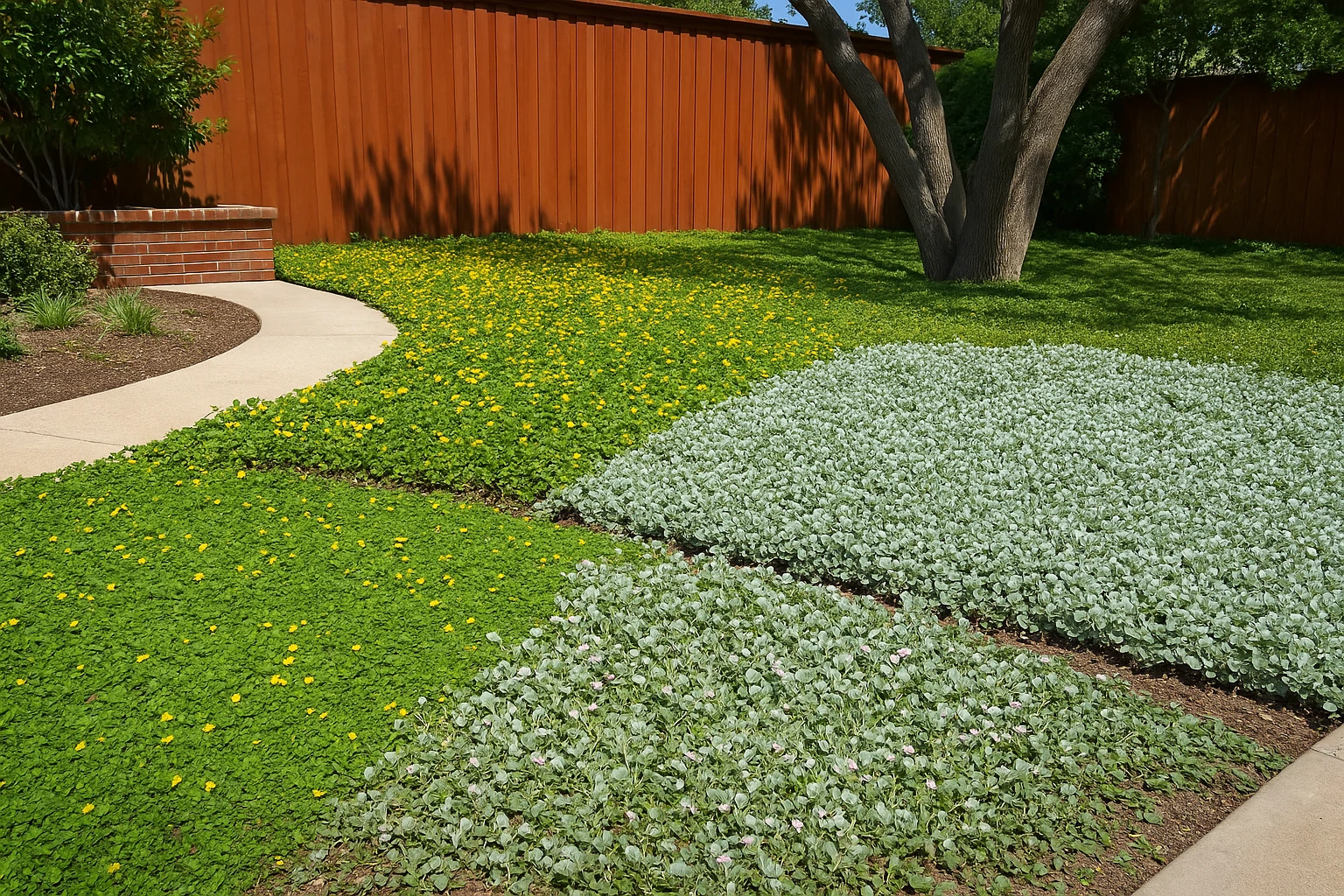
Grass demands mowing, watering, and feeding. Ground covers do not. They grow low, spread wide, and stay green. This swap can save hours each week and thousands each year.
Try native ground covers like:
- Horseherb: Grows in sun or shade. Needs little water.
- Silver Ponyfoot: Fast spreader. Bright silver color.
- Frogfruit: Stays low and blooms with tiny flowers. Attracts bees and butterflies.
You can mix ground covers with stepping stones or gravel paths. This breaks the space and adds contrast. Ground covers also fight weeds. Their dense growth blocks sun from the soil and stops weed seeds from growing.
In large yards, mix types to cover slopes, corners, or fence lines. Keep them trimmed once or twice a season. That is much easier than mowing every week.
Need more smart ways to handle your garden without extra hassle? Browse the Garden Advice by Homenumental for practical tips that work in every season.
Choose Low-Care Trees and Shrubs
Trees and shrubs give shape, shade, and structure. Pick ones that do not drop too many leaves or need pruning every month. Choose slow-growing, hardy types that survive Texas heat and cold.
Good trees for Texas
- Cedar Elm: Tough, tall, and drought-tolerant.
- Texas Red Oak: Deep roots and red fall color.
- Desert Willow: Blooms in summer. Needs little water.
Easy shrubs to try
- Texas Lantana: Bold color and strong scent.
- Autumn Sage: Compact, with red or pink flowers.
- Dwarf Yaupon Holly: Evergreen and neat.
Plant trees at least 10–15 feet from the house. This keeps roots clear of pipes and foundations. Place shrubs in groups for fullness. Keep mulch around the base and water deeply during dry weeks.
Trees and shrubs grow slow but last long. A few strong plants can shape your yard for years without heavy care.
Skip the Flowers That Fade Fast
Many flowers bloom once and die. They ask for daily water, weekly care, and frequent replanting. That adds work. Instead, use perennials or evergreens that stay strong and need less help.
Texas-friendly perennials include:
- Purple Coneflower: Bright and hardy.
- Coreopsis: Yellow blooms that last.
- Salvia Greggii: Grows wild in dry places.
Evergreen plants like boxwood, rosemary, and juniper give structure year-round. They need shaping only once a year. Some, like rosemary, even smell good and can be used in cooking.
Limit flower beds to key spots. Place them near doors or patios where you spend time. Keep other areas simple with rocks, shrubs, or ground covers. You get beauty without the burden.
Limit Your Tools and Supplies
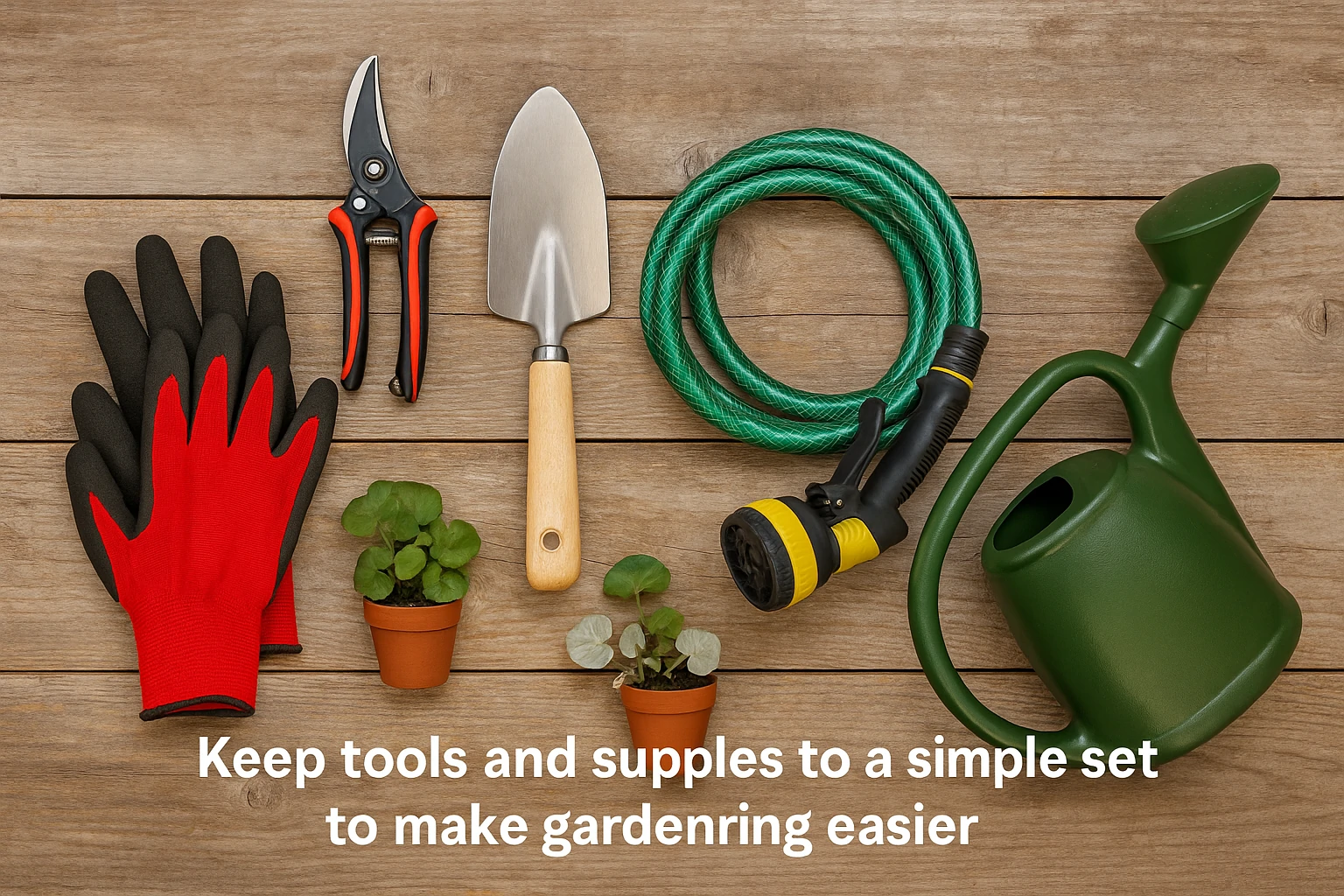
Low-effort yards need fewer tools. You do not need a mower, blower, or spreader if you skip the grass and heavy flowers. A simple toolkit can keep everything in check.
Essentials include:
- Hand pruners
- Trowel or small shovel
- Garden gloves
- Hose with spray nozzle
- Watering can for containers
Store tools in a dry, easy-to-reach place. Clean blades after use. Check for rust. Sharp tools last longer and work better.
Fewer tools also mean fewer expenses. You save space, time, and money. That makes your landscape even easier to enjoy.
Attract Wildlife the Natural Way
Texas supports birds, bees, butterflies, and more. You can welcome them with no extra effort. Just use plants they love. That adds life and sound to your yard, all without added chores.
Best plants for wildlife:
- Milkweed: Monarchs lay eggs here.
- Coral Honeysuckle: Hummingbirds flock to this.
- Sunflowers: Birds feed on seeds.
Add a shallow water dish. Keep it clean and shaded. Place flat stones near it for bees and butterflies to land. Do not use sprays or poisons. They harm good bugs and birds.
Wildlife needs space. Keep part of your yard open. Let native grass grow taller in one corner. A “wild patch” brings balance. You still get beauty, but you also support nature.
Use Wind and Water Features Wisely
A small fountain or wind chime adds charm. Sound makes your space feel peaceful. But you want features that work with little care.
Use solar fountains. They run during the day and shut off at night. No wires. No timers. Clean them once a month to stop algae.
Place wind chimes where they catch the breeze but don’t annoy. Bamboo sounds soft. Metal chimes are louder. Test a few and see what fits.
Skip big ponds or pumps. They demand filters, checks, and cleanups. Choose small accents instead. Less work, more calm.
Keep Maintenance on a Schedule
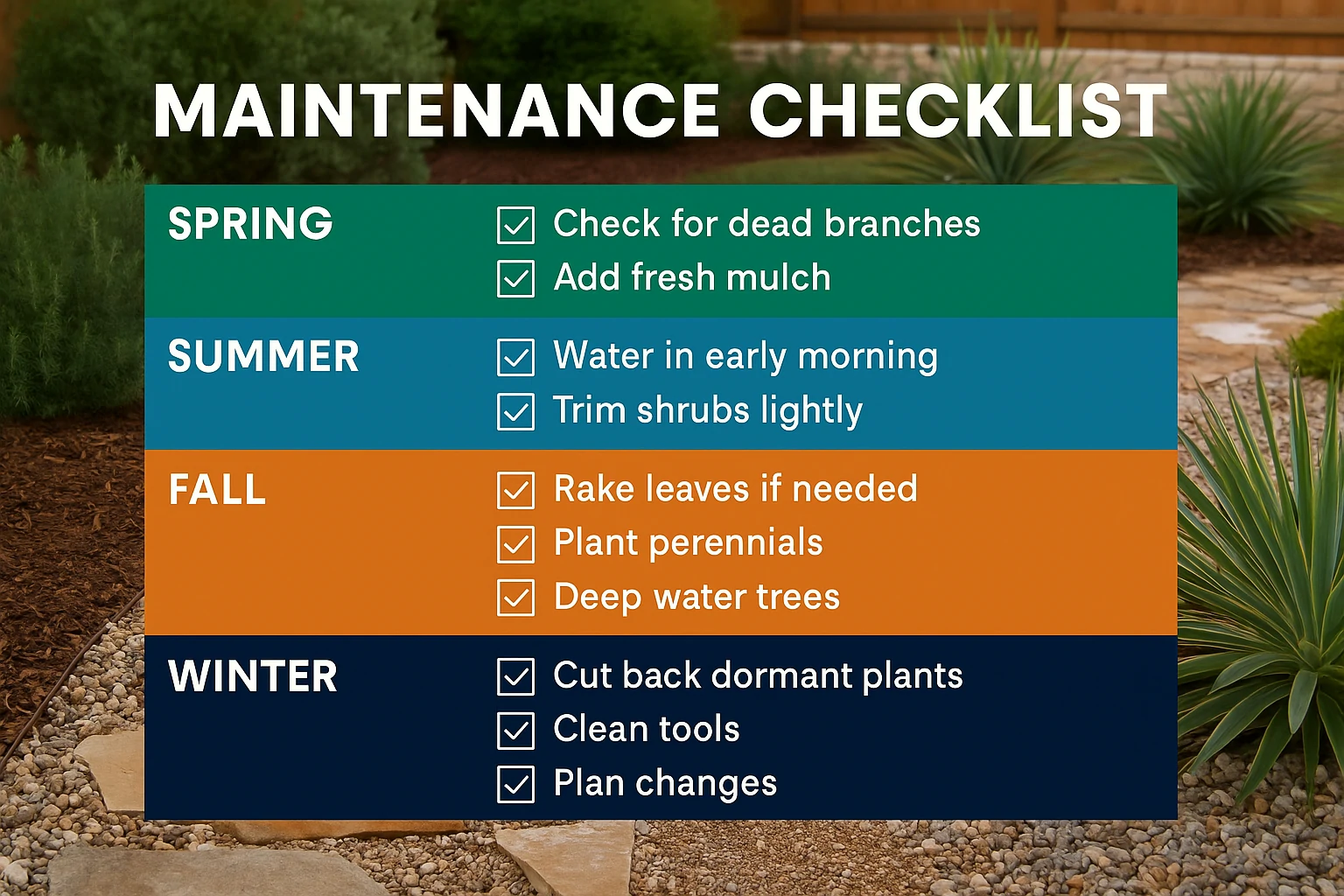
Even low-care yards need some love. But if you plan ahead, the work stays light. Build a simple schedule that covers tasks each season.
Spring
- Check for dead branches
- Add fresh mulch
- Test irrigation
Summer
- Water in early morning
- Trim shrubs lightly
- Watch for pests
Fall
- Rake leaves if needed
- Plant perennials
- Deep water trees
Winter
- Cut back dormant plants
- Clean tools
- Plan changes
Set one weekend per season to check the yard. This keeps things tidy without becoming a chore. A little work now saves big work later.
Bonus Tip: Start Small With One Zone (Real Example)
| Step | What to Do | Real Example: Daniel in Fort Worth |
|---|---|---|
| 1 | Pick one small area near your patio or walkway. | Daniel chose a sunny corner where grass had died. |
| 2 | Clear the space. Lay down mulch or gravel. | He used river rock and metal edging to shape the zone. |
| 3 | Add 2–3 low maintenance plants. | Daniel planted one dwarf yaupon holly and two Mexican feather grasses. |
| 4 | Water once to establish, then let it thrive. | That section now survives with no watering and still looks great year-round. |
Tip: You don’t need to overhaul your whole yard. Start with one spot. Small wins make a big impact over time.
For more tips on creating a simple, efficient outdoor space that fits your lifestyle, check out the Wutawhelp Home Guides. You’ll find helpful ideas that match your needs without adding extra work.
Final Thoughts
A Texas yard does not need to be costly or hard to manage. You can build a clean, strong landscape with smart choices that match the climate and your lifestyle. You do not need a big team or expensive tools. You only need to plan with care and keep things simple.
Pick native plants. Avoid grass when you can. Use rocks, gravel, mulch, and raised beds to shape your space. Add shade where needed. Choose plants that live on little water. Let nature work with you, not against you.
Your yard should bring peace, not stress. Every part of this guide gives you a step toward that goal. You lower costs. You save time. You keep beauty without the burden.
Start small. Pick one area to improve this month. Add more over time. Soon, your yard will not feel like a chore. It will feel like home.

